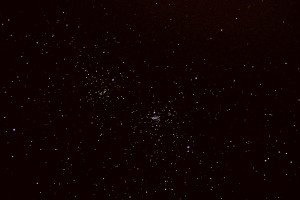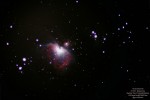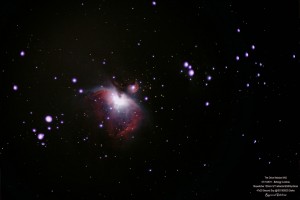The large gas giant is always worth spending some time observing the cloud belts, and if your lucky enough try to view the large red spot (giant swirling storm). I also find it interesting to note the positions of the 4 main moons, Ganymede, Callisto, Europa and Io.
Some interesting facts about Jupiter.
At present (Nov 2011) Jupiter is roughly 369 Million Miles from Earth.
Jupiter (5th Planet from the Sun) is large enough to hold over 1,300 earth size planets.
The Giant red spot is actually a storm that has been raging for over 300 years with winds of 250mph + and is large enough to hold 100 earth size planets within the storm.
Jupiter has over 60 moons orbiting the planet, the 4 largest are Ganymede, Callisto, Europa and Io.
Ganymede has a visual mag of 4.6
Callisto has a visual mag of 5.6
Europa has a visual mag of 5.3
Io has a visual mag of 5.0
One of my favourite objects is the double cluster in Perseus and it’s best viewed October – January.
NGC 869 is also know as “h Persei” is composed of over 350 stars and is over 70 light years in diameter and over 7,500 light years distant from us. NGC 884 is also know a s “Chi Persei” and has over 300 stars in its group and roughly the same distance away as NGC 869.
s “Chi Persei” and has over 300 stars in its group and roughly the same distance away as NGC 869.
I can spend hours looking at these two clusters and I always find something of interest. The constellation Perseus has many open clusters, Nebula and a Galaxy. The double cluster is a jewel.
in the night sky, low power shows it best and it is always one of my test objects for sky clarity.
Also in November Orion rises in the evenings and make a stunningly beautiful sight in any size scope,
The diffuse nebula is the birthplace of stars and is at least 1.500 light years distant from us.
This is an Image (right) I took the other evening using a short tube refractor 120mm diameter and a EQ5 mount with SynScan tracking.


Great pictures Ray! I love the Orion Nebula pic. I remember a year ago we talked about you blogging 🙂 I am glad you decided to do it. It’s awesome!
Hi Ray,
Wonderful article! The images are superb and if right clicked the full sizes are in the library here! The SynScan technology is fascinating!
Thank you!